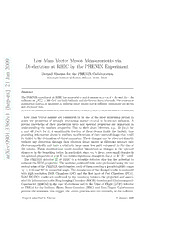Table Of Content9 Low Mass Vector Meson Measurements via
0
0 Di-electrons at RHIC by the PHENIX Experiment
2
n Deepali Sharma for the PHENIX Collaboration
a
J Weizmann Institute of Science, Rehovot, 76100, Israel
1
2
] Abstract
x
e
ThePHENIXexperimentatRHIChasmeasuredω andφmesonsinp+p,d+AuandAu+Au
-
p collisionsat√sNN =200GeVviabothhadronicanddi-electrondecaychannels.Thetransverse
e momentumspectraasmeasuredindifferentdecaymodesandatdifferentcentralitiesareshown
h and discussed here.
[
1
v Low Mass Vector mesons are considered to be one of the most interesting probes to
0 study the properties of strongly interacting matter created in heavy-ion collisions. A
6
precise knowledge of their production rates and spectral properties are important in
3
understanding the medium properties. Due to their short lifetimes, e.g., 23 fm/c for
3
. ω and 46 fm/c for φ, a considerable fraction of them decays inside the fireball, thus
1
providing information about in-medium modifications of their spectral shape that could
0
9 be linked to the restoration of chiral symmetry. These changes can be observed directly
0 without any distortion through their dilepton decay modes as dileptons interact only
: electromagnetically and have a relatively large mean free path compared to the size of
v
i the system. These modifications could manifest themselves as changes in the spectral
X
shapes or in the branching ratios. In particular, since m ≈2m , even small changes in
φ K
r thespectralpropertiesofφorK caninducesignificantchangesintheφ→K+K− yield.
a
The PHENIX detector [1] at RHIC is a versatile detector that has the potential to
measurethe LVMproperties.The analysespresentedhere were performedusing the two
centralarmsofthePHENIXspectrometer,eachofthemcoveringapseudorapidityrange
◦
|η| <0.35and90 inazimuthalangle.Themomentumofthechargedtracksismeasured
with high resolution Drift Chambers (DC) and the first layer of Pad Chambers (PC1).
Valid DC-PC1 tracks are confirmed by the matching between the projected and associ-
atedhitinformationtotheRingImagingCˇerenkov(RICH)detectorandElectromagnetic
Calorimeter (EMCal) in the case of electrons and to the Time of Flight (TOF) detector
or EMCal for the hadrons. Beam Beam Counters (BBC) and Zero Degree Calorimeters
provide the minimum bias trigger,the vertexposition and the centrality of the collision.
PreprintsubmittedtoElsevier 21January2009
The φ, ω → e+e− and φ → K+K− decays were reconstructed by combining the
oppositely charged identified particles into pairs to form invariant mass spectra that
containboththesignalandacombinatorialbackgroundofuncorrelatedpairs.Theshape
and amount of the combinatorial background in Au + Au (φ → e+e−,K+K−) and
d+ Au (φ → e+e−) analyses, were estimated using an event mixing procedure. The
spectra, after subtracting the combinatorial background, were then fit in the vicinity of
the meson masses to a Breit-Wigner (BW) function convoluted with a Gaussian to take
into account the detector resolution, to extract the raw yield. For other analyses, the
yield extraction was done by fitting the raw peaks to a BW function convoluted with a
Gaussian for the signal and a polynomial of order two for the underlying background.
The φ→K+K− analysis in p+p and d+Au was done using three different techniques.
One required both charged tracks to be identified as kaons using the TOF or EMCal
detectors, the second one required only one to be identified as kaon in the TOF and
the last one assumes that all the charged tracks are kaons. Results of all the three
techniques show good agreement to each other as can be seen in Fig. 1(a). The ω →
π0γ and ω → π0π+π− decays were reconstructed by combining π0 (reconstructed via
π0 → γγ) candidates with all other photons from the same event or with a pair of
oppositely charged unidentified tracks, respectively. The raw yields were extracted by
fitting the invariantmassdistributions aroundtheω peakwith aGaussianforthe signal
and a parabolic function for the background. The extracted raw yields are corrected
for reconstruction efficiency that includes geometrical acceptance, track reconstruction,
detector performance and analysis cuts. The correction function is determined using an
event generator and a GEANT based simulation of the PHENIX detector.
Fig.1(a)showstheφinvariantm spectrameasuredviaK+K−ande+e−decaymodes
T
inp+p andd+Au collisions.The twodecaymodes areinreasonableagreementto each
otherinbothsystems.Thelimitedstatisticsinφ→e+e− ind+Audonotallowustogo
to highp values.The m spectrameasuredinAu+AuareshowninFig.1(b)and1(c)
T T
for e+e− and K+K−, respectively with a fit to an exponential function to extract the
rapidity density dN/dy and the temperature T. The temperatures extracted in the two
decay channels are in good agreement with each other as seen in Fig. 1(d), whereas an
increase of the normalized yield from d+Au collisions to peripheral Au+Au collisions
canbeseenforbothe+e− andK+K−inFig.1(e)[2].ThedielectronyieldintheAu+Au
channelseemstobehighercomparedtothedikaonchannel,butthelargesystematicand
statistical uncertainties in the e+e− measurement prevent us from making a definitive
statement.Themeasurementsareexpectedtoimproveinfuturewiththenewlyinstalled
Hadron Blind Detector [3]. The p spectra of ω meson measured using e+e−, π0γ and
T
π0π+π− are shown in Fig. 1(f) and 1(g). The spectra show good agreement among the
different decay channels in all the three systems p+p, d+Au and Au+Au. The solid
curve in Fig. 1(g) is the p parameterizationof the π0 yield measuredin p+p collisions
T
and the dashed curves are the p+p fits scaled by the corresponding number of binary
collisions.Thecurvesdescribeprettywellthemeasuredspectraind+Auandperipheral
Au+Aucollisions,whereasfor centralAu+Aucollisions,the measuredpoints liebelow
the curve, indicating some suppression.
References
[1] PHENIXdetector overviewK.Adcoxetal.,NIMA499469-477(2003).
2
[2] A.Kozlov,Nucl.Phys.A774(2006) 739-742
[3] I.Ravinovich,Nucl.Phys.A774:903-906,2006
3
Fig.1.mT spectraforφin(a)p+pandd+Aucollisionsviae+e− and K+K−,(b)Au+Au(e+e−)
and(c)Au+Au(K+K−)(c).(d)and(e)showTanddN/dyforthetwodecaychannelsvsmultiplicity.
pT spectraofω areshownin(f)forp+pandd+Auandin(g)forAu+Aucollisions.
4
This figure "decadal-plot1.png" is available in "png"(cid:10) format from:
http://arXiv.org/ps/0901.3360v1
This figure "dn_dy_npart_phi1.png" is available in "png"(cid:10) format from:
http://arXiv.org/ps/0901.3360v1
This figure "Inv_omega_AuAu_ee_hadronic_spec_v4.png" is available in "png"(cid:10) format from:
http://arXiv.org/ps/0901.3360v1
This figure "Inv_spec_phi_pp_d_au_v6.png" is available in "png"(cid:10) format from:
http://arXiv.org/ps/0901.3360v1
This figure "omega_p_dau.png" is available in "png"(cid:10) format from:
http://arXiv.org/ps/0901.3360v1
This figure "phi_ee_au_au_kozlov.png" is available in "png"(cid:10) format from:
http://arXiv.org/ps/0901.3360v1

